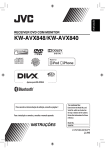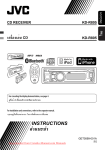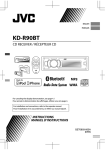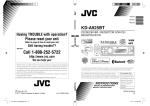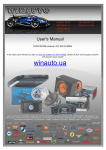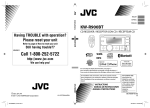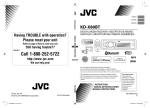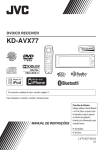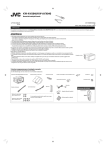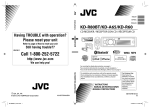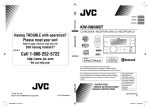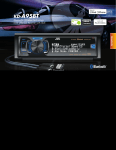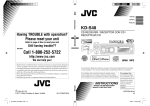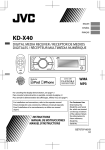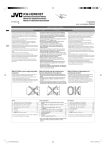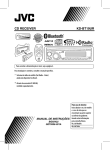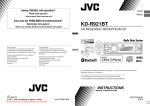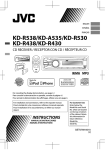Download JVC Car Audio User Manual
Transcript
.
.
KD-A95BT
CD RECEIVER / RECEPTOR CON CD / RÉCEPTEUR CD
For installation and connections, refer to the separate manual.
INSTRUCTIONS
For Customer Use:
Enter below the
Model No. and Serial
No. which are located
on the top or bottom
of the cabinet. Retain
this information for
future reference.
Model No.
Serial No.
Thank you for purchasing a JVC product.
Please read all instructions carefully before operation, to ensure your complete understanding and to
obtain the best possible performance from the unit.
For U.S.A.
This equipment has been tested and found to comply with the limits for a Class B digital device,
pursuant to Part 15 of the FCC Rules. These limits are designed to provide reasonable protection
against harmful interference in a residential installation. This equipment generates, uses, and can
radiate radio frequency energy and, if not installed and used in accordance with the instructions,
may cause harmful interference to radio communications. However, there is no guarantee that
interference will not occur in a particular installation. If this equipment does cause harmful
interference to radio or television reception, which can be determined by turning the equipment
off and on, the user is encouraged to try to correct the interference by one or more of the
following measures:
– Reorient or relocate the receiving antenna.
– Increase the separation between the equipment and receiver.
– Connect the equipment into an outlet on a circuit different from that to which the receiver is
connected.
– Consult the dealer or an experienced radio/TV technician for help.
Caution:
Changes or modifications not expressly approved by the party responsible for compliance could
void the user’s authority to operate the equipment.
Use of controls or adjustments or performance of
procedures other than those specified herein may
result in hazardous radiation exposure.
In compliance with Federal Regulations, following
are reproductions of labels on, or inside the
product relating to laser product safety.
JVC KENWOOD Corporation
2967-3, ISHIKAWA-MACHI,
HACHIOJI-SHI, TOKYO, JAPAN
THIS PRODUCT COMPLIES WITH DHHS RULES
21CFR SUBCHAPTER J IN EFFECT AT DATE OF
MANUFACTURE.
Location: Bottom Plate
IMPORTANT FOR LASER PRODUCTS
1. CLASS 1 LASER PRODUCT
2. CAUTION: Do not open the top cover. There are no user serviceable parts inside the unit;
leave all servicing to qualified service personnel.
3. CAUTION: (For U.S.A.)
Visible and/or invisible class II laser radiation when open. Do
not stare into beam.
(For Canada) Visible and/or invisible class 1M laser radiation when open. Do
not view directly with optical instruments.
4. REPRODUCTION OF LABEL: CAUTION LABEL, PLACED OUTSIDE THE UNIT.
[European Union only]
Warning:
Stop the car before operating the unit.
Caution:
Adjust the volume so that you can hear sounds
outside the car. Driving with the volume too high
may cause an accident.
Avoid using the USB device or iPod/iPhone if it
might hinder driving safety.
Caution on volume setting:
Digital devices (CD/USB) produce very little noise
compared with other sources. Lower the volume
before playing these digital sources to avoid
damaging the speakers by the sudden increase of
the output level.
Temperature inside the car:
If you have parked the car for a long time in hot
or cold weather, wait until the temperature in the
car becomes normal before operating the unit.
appears on the display and animation/text
scroll will be stopped to prevent the display from
being blurred when the temperature falls below
0°C. Once operating temperature is normalised,
these functions will start working again.
Condensation:
When the car is air-conditioned, moisture may
collect on the laser lens. This may cause disc read
errors. In this case, remove the disc and wait for
the moisture to evaporate.
Maintenance
Cleaning the unit
Wipe off the dirt on the panel with a dry silicon or
soft cloth. Failure to observe this precaution may
result in damage to the unit.
Cleaning the connector
Wipe off dirt on the connector of the unit and
panel. Use a cotton swab or cloth.
How to read this manual:
This manual mainly explains operations using
the buttons on the control panel.
< > indicates the displays on the control
panel.
[XX] indicates the initial setting of a menu
item.
How to attach the control panel
How to reset your unit
Your preset adjustments will also
be erased.
How to forcibly eject a disc
How to detach the control panel
Avoid touching the connectors.
(Hold)
Be careful not to drop the disc when it ejects.
If this does not work, reset your unit.
Preparation
Canceling the display
demonstration
The display demonstration is always turned on
unless you cancel it.
1
(Hold)
SET UP
PUSH
DEMO
Setting the clock
1
(Hold)
PUSH
Clock
DEMO
Clock
DEMO
Off
PUSH
Clock
Color
3 Select <Set Clock>.
On
(Initial setting)
3 Select <Off>.
Clock
Clock Display
PUSH
Set Clock
24/12H
DEMO
4 Adjust the hour.
Off
Set Clock
PUSH
DEMO
Clock
2 Select <Clock>.
PUSH
2
SET UP
On
4 Press MENU to exit.
1 : 00AM
PUSH
(Initial setting)
5 Adjust the minute.
Set Clock
1 : 00AM
PUSH
6 Select <24H/12H>.
Clock
Set Clock
PUSH
24/12H
Clock Adjust
7 Select <24Hours> or <12Hours>.
8 Press MENU to exit.
Basic operations
Basic operations
Control panel
Remote controller
Display window
Flips down the panel
Remote sensor
Aim the remote controller directly at the sensor.
DO NOT expose to bright sunlight.
Control dial
When you press or hold the following button(s)...
Control panel
Remote
controller
General function
SOURCE
Turns on.
Turns off. (Hold)
Press the /SOURCE button on the control panel and turn
the control dial within 2 seconds to select the source.
Press repeatedly to select the source.
Control dial
(turn)
VOL - / +
Adjusts the volume level.
Control dial
(press)
)
EQ
SOUND
/SOURCE
—
—
—
Selects items.
Mutes the sound or pauses playback.
Press the button again to cancel muting or resume
playback.
Confirms selection.
Selects the preset sound mode. (' page 23)
Enters “Hands-Free” menu (' page 18), or answers
incoming call when the unit rings.
Ends a call. (Hold)
Returns to the previous menu.
—
—
Selects a preset station (' page 7)/category (' page 10).
Searches for HD Radio stations only. (Hold)
Searches for HD Radio multicast channels.
Selects MP3/WMA/WAV folder.
Searches for a station automatically. Searches
for a station manually. (Hold)
Selects track /Satellite Radio channel. Fast-forwards or
reverses track. / Changes Satellite Radio
channel rapidly. (Hold)
/
/
/
/
Basic operations
Display information
Changes the display information. (Press)
Scrolls the current display information. (Hold)
Source
Radio
HD Radio
Satellite Radio
CD/USB/Bluetooth Audio
iPod/iPhone (Headunit Mode/iPod
Mode)
iPod/iPhone (Application Mode)
Pandora姞 internet radio
External Components
*1
*2
Display (Normal display pattern)*1
Non-Radio Broadcast Data System station: Frequency
FM Radio Broadcast Data System station: Programme
type (PTY)/Frequency/Station name (PS)
Track title*2/Album title*2/Frequency
Category name/Channel name/Track title
Track title/Album title/Artist*
* “No Name” appears for conventional CDs or if not
recorded.
Application Mode
Station name/Album title/Track title
Ext Input or Aux In
Display information varies for large font and large clock display patterns.
“No Text” appears when no text is received.
Radio
Searching for a station
B A
ST NATURAL 1:00AM
FM
88.3 MHz
Select <FM> or <AM>.
Auto search. (Press)
Manual search. (Hold)
“M” appears, then press the button repeatedly.
“ST” lights up when receiving an FM stereo broadcast with sufficient signal strength.
Storing stations in memory
Manual presetting
2 Select preset number.
While listening to a station...
The preset number flashes.
You can preset up to 18 stations for FM and 6
stations for AM.
1
(Hold)
“Preset Mode” screen appears.
Radio
Auto presetting (FM)
SSM (Strong-station Sequential Memory)
You can preset up to 18 stations for FM.
If an HD Radio tuner box is connected, you can
also preset up to 6 stations for AM.
1
4 Set the activation time..
5 Press MENU to exit.
(Hold)
2
-<Tuner>
-<SSM>
-<SSM 01 – 06>
“SSM” appears. When all the stations are stored,
“SSM” disappears.
To preset <SSM 07 – 12>/<SSM 13 – 18>,
repeat steps 1 and 2.
Selecting a preset station
Searching for your favorite
Programs—Program Type (PTY)
Search
This feature is only available for FM Radio
Broadcast Data System stations.
1
You can also select a preset station using / .
Setting the Radio Timer
You can tune in to a preset station at a specific
time regardless of the current source.
1
(Hold)
2
[Off]
-<Tuner>
-<Radio Timer>
-<Off>/<Once>/
<Daily>
Cancels Radio Timer.
Once
Activates once.
Daily
Activates daily.
3 Select the preset station.
-<FM>/<AM>
-<1> ... <18> for FM/
<1> ... <6> for AM
lights up after the Radio Timer has been set.
Only one timer can be set. Setting a new timer
will override the previous setting.
The Radio Timer will not activate if the unit is
turned off or if <AM> is set to <Hide> after
selecting an AM station for the timer.
(' page 30)
(Hold)
2 Select a PTY code.
.PTY Search starts.
If there is a station broadcasting a program of the
same PTY code as you have selected, that station is
tuned in.
PTY codes
News, Inform (Information), Sports, Talk, Rock, Cls Rock
(Classic Rock), Adlt Hit (Adult Hits), Soft Rck (Soft Rock), Top
40, Country, Oldies, Soft, Nostalga (Nostalgia), Jazz, Classicl
(Classical), R & B (Rhythm and Blues), Soft R & B (Soft Rhythm
and Blues), Language, Rel Musc (Religious Music), Rel Talk
(Religious Talk), Persnlty (Personality), Public, College, Habl
Esp (Spanish Talk), Musc Esp (Spanish Music), Hip Hop,
Weather
HD Radio™ tuner control
This unit can control the JVC KT-HD300 HD Radio tuner box (separately purchased).
Refer to the KT-HD300 instruction manual for installation and connection details.
HD Radio tuners can also tune in to conventional analog broadcasts.
Many HD Radio stations offer more than one channel of programming. This service is called
multicasting.
Searching for a station
B A
AT HD NATURAL
1:00AM
WXYZ-HD1
Classic Hits
Classic Hits Album
FM
92.5 MHz
HD Radio
HD Radio station
Select <FM> or <AM>.
Auto search. (Press)
Manual search. (Hold)
“M” appears, then press the button repeatedly.
HD Radio multicast channel
First four letters of Call Sign
Call Sign
HD Radio
HD Radio AT HD NATURAL 1:06AM
AT HD NATURAL 1:06AM
WXYZ-HD
Classic Hits
Classic Hits
WXYZ-HD-1
Channel number
Searching for HD Radio stations
only
HD Radio
(Hold)
AT NATURAL 1:08AM
HD-SEARCH
“HD” flashes when a station is tuned in, and
searching stops.
Selecting an HD Radio multicast
channel
Changing HD Radio reception
mode
While receiving an HD Radio broadcast, you can
change the reception mode—digital or analog.
This setting does not take effect for the
conventional FM/AM stations.
1
(Hold)
2
When receiving HD Radio multicast channels...
Select your desired channel
(HD1 to HD8).
[Auto]
“Linking” appears while linking to a multicast
channel.
-<Tuner>
-<Blend Hold>
-<Auto>/<Analog>/
<Digital>
Switches between digital and
analog audio automatically.
“HD” flashes if the radio station
forces only analog reception.
Analog
Tunes to analog audio only.
“ANA” lights up.
Digital
Tunes to digital audio only.
“DIGI” lights up.
The setting automatically returns to <Auto>
when you tune in to another broadcast.
For storing stations in memory and selecting a
preset station, ' page 6.
Satellite Radio tuner control
Before operating, connect either one of the following systems (not supplied) to the expansion port on
the rear of this unit. Refer to the “Installation/Connection Manual” for details.
SIRIUS Satellite
Radio
XM Satellite
Radio
JVC KS-SRA100 (SIRIUS Satellite Radio interface) and
SCC1 (SiriusConnect Vehicle Tuner) or
SCVDOC1 (SiriusConnect Vehicle Docking Kit) and SIRIUS radio
XMDJVC100 (Smart Digital Adapter for JVC) and XM Universal Tuner Box
CNPJVC1 (Connection cable for JVC) and CNP2000UCA (Protocol Interface
Adapter and XM Direct 2 Tuner)
For details, refer also to the instructions supplied with the other components.
Activating your SIRIUS
subscription
Activating your XM subscription
1 Select <XM>.
1 Select <SIRIUS>.
SIRIUS Satellite Radio starts updating the SIRIUS
channels. Once completed, SIRIUS Satellite Radio
tunes in to the Preview Channel.
2 Select “Channel 0” to check your SIRIUS ID.
The 12-digit SIRIUS ID will be displayed.
You can also check your SIRIUS ID from the
label on the packaging, or from menu
operations (' page 29).
XMDirect2 Tuner System starts updating all the
XM channels. “Channel 1” is tuned in
automatically.
2 Select “Channel 0” to check your XM
Satellite Radio ID.
The display alternates between “RADIO ID” and
the 8-digit alphanumeric ID number.
You can also check your XM Satellite Radio ID
labeled on the casing of the XMDirect2 Tuner
System.
3 Contact Sirius Satellite Radio on the
internet activate now> to
activate your subscription.
3 Contact XM Satellite Radio on the internet
Once subscription has been activated, “SUB
UPDATE PRESS ANY KEY” appears on the display.
Once subscription has been activated, the unit
can be tuned to one of the available channels.
Channel Updates (SIRIUS)
If channels are updated after subscription,
updating starts automatically. “UPDATING”
appears and no sound can be heard.
Updates take a few minutes to complete.
During an update, you cannot operate your
Satellite Radio.
activate your subscription.
Satellite Radio tuner control
Selecting a channel
C
Selecting a preset station/
category/channel from the list
A
1
B
“List” menu appears.
Select <SIRIUS> or <XM>.
Select a category.
If you want to select channels of all categories...
SIRIUS: Select <ALL>.
XM: Skip this step.
Select a desired channel.
Holding the button changes the channels rapidly.
While searching, invalid and unsubscribed
channels are skipped.
Storing stations in memory
You can preset up to 18 channels for both SIRIUS
and XM.
While listening to a station...
1
(Hold)
“Preset Mode” screen appears.
2 Select preset number.
The preset number flashes.
2 Select <Preset>, <Category> or
<Channel>.
If a category is selected, the first channel of this
category is tuned in.
3 Select a desired item.
CD/USB
CD/USB
Playing a CD/USB device
Label side
USB cable from the rear
of the unit
or
The source changes to “CD” and playback starts.
The source changes to “USB” and playback starts.
This unit can play MP3/WMA files stored in CD-R, CD-RW, and MP3/WMA/WAV files in USB mass
storage device (such as a USB memory and Digital Audio Player).
Make sure all important data has been backed up. We shall bear no responsibility for any loss of data
in USB mass storage class device while using this system.
Ejected disc not removed within 15 seconds will reload automatically.
If the disc cannot be ejected,
Selecting a folder/track
Selects folder.
(For MP3/WMA/WAV)
Selecting the playback modes
You can select one of the following playback
modes at a time.
1
Selects track. (Press)
Fast-forwards or reverses the
track. (Hold)
Selecting a track/folder from
the list
1
2 Select a folder. (For MP3/WMA/WAV)
3 Select a track.
(Hold)
<Repeat>)<Random>
2
Repeat Off
Cancels repeat playback.
Track
Repeats current track.
Folder *
Repeats current folder.
Random Off
Cancels random playback.
Folder *
Randomly plays all tracks of
current folder, then tracks of
next folders.
All
Randomly plays all tracks.
* For MP3/WMA/WAV
For MP3/WMA/WAV
If there are many folders or tracks, you can fast
search for the desired folder or track by turning
the control dial quickly, or use Quick Search
iPod/iPhone
Playing an iPod/iPhone
USB cable from the rear
of the unit
or
2 Select the desired list.
Playlists)Artists)Albums)Songs)
Podcasts)Genres)Composers)
Audiobooks) (back to the beginning)
3 Select the desired track.
USB 2.0 cable (not supplied)*
The source changes to “iPod-1/iPod-2” and
playback starts.
* Recommend to use a cable suitable for car use.
Selecting the control mode
-<Headunit Mode>/
<iPod Mode>/
<Application Mode>
Controls iPod playback through
this unit.
Repeat this step until the desired track is selected.
If the selected menu contains many tracks, you
can fast search for the desired track by turning
the control dial quickly, or use Quick Search
(Hold)
Headunit
Mode
iPod Mode
Controls iPod playback from the
iPod/iPhone.
Application
Mode
The sound of any functions
(music, games, applications, etc.)
running on the connected iPod/
iPhone is emitted through the
speakers connected to this unit.
You can also change the setting using <iPod
Switch> in the menu.
Selecting a track
Applicable under <Headunit Mode>/<iPod
Mode> only.
For <Application Mode>, applicable only for
some audio applications.
Selects track/chapter. (Press)
Fast-forwards or reverses the
track. (Hold)
Selecting a track from the list
Applicable under <Headunit Mode> only.
1
Selecting the playback modes
Applicable under <Headunit Mode> only.
You can select one of the following playback
modes at a time.
1
(Hold)
<Repeat>)<Random>
2
Repeat Off
Cancels repeat playback.
One
Functions the same as “Repeat
One” of the iPod.
All
Functions the same as “Repeat
All” of the iPod.
Random Cancels random playback.
Off
Song
Functions the same as “Shuffle
Songs” of the iPod.
Album
Functions the same as “Shuffle
Albums” of the iPod.
“Album” is not applicable for some iPod/
iPhone.
iPod/iPhone application
You can operate JVC original application with this
unit in <Application Mode>
Pandora姞 internet radio
Preparation
1 Search for “Pandora” in the Apple iTunes
App Store to find and install the most
current version of the Pandora姞
application onto your device.
2 In the application on your device, log in
and create an account with Pandora姞
iPod/iPhone
Creating a new station
You can create a new station based on the
currently playing song or artist.
1
2
-<NEW STATION>
-<From Artist>/
<From Song>
A new station is created based on the current
song or artist.
Searching the registered station
from the list
1
2 Select the station list display mode.
Pandora姞 is only available in the US.
Because Pandora姞 is a third-party service, the
specifications are subject to change without
prior notice. Accordingly, compatibility may be
impaired or some or all of the services may
become unavailable.
Some functions of Pandora姞 cannot be
operated from this unit.
Listening to
Pandora姞 internet radio
1 Open the Pandora姞 application on your
device.
2 Connect the device to one of the USB
terminals.
The source switches and broadcast starts
automatically from your current station.
Basic Operations
BY DATE According to the registration date
A-Z
Alphabetical order
You can proceed directly to step 3 to select
station or use the search menu to scroll through
the desired menu.
3 Select the desired station.
To bookmark song/artist information
While receiving a song...
(Hold)
-<BOOKMARK>
Starts/pauses playback.
Selects thumbs up/thumbs
down.
If thumbs down is selected,
current track is skipped.
Skips track.
<This Artist>)<This Track>
“BOOKMARKED” appears and the song/artist
information is stored to the iPod/iPhone.
This unit allows you to bookmark songs and/or
artists in your personalized Pandora姞 account.
The bookmarks will not be available for review
on the unit but will be available in your
Pandora姞 account.
Quick
Search
Quick
Search
If you have many folders/tracks/contacts, you can search through them quickly according to the first
character (A to Z, 0 to 9 and OTHERS).
1 Enter list menu or “Hands-Free” menu.
CD (MP3/WMA)/
USB (MP3/WMA/WAV)
iPod/iPhone
Bluetooth phonebook
Select the desired list.
Select <Phonebook>.
2 Select the desired character (A to Z, 0 to 9
and OTHERS).
“OTHERS” appears if the first character is not A to
Z or 0 to 9, such as #, -, !, etc.
3 Select your desired folder/track/contact.
For CD/USB and iPod/iPhone, repeat step 3 until
the desired track is selected.
Searching may not work on some of the layers
of the selected menu (for iPod/iPhone).
External components
You can connect an external component to the following terminals:
EXT IN: Expansion port on the rear of this unit using the following adapters (not supplied):
- JVC KS-U57, Line Input Adapter
- JVC KS-U58, AUX Input Adapter
AUX: AUX (auxiliary) cable from the rear of the unit.
For details, refer also to the instructions supplied with the adapters or external components.
For connection to expansion port on the rear of this unit, refer to the “Installation/Connection Manual”.
Playing an external component
from AUX/expansion port
Portable audio
player, etc.
1 Connect to AUX cable and/or the
expansion port from the rear of the unit.
2 Set the source as necessary.
(Hold)
Select <Show>.
AUX
3.5 mm (1/8") stereo mini plug
(not supplied)
Use a 3-terminal plug head
stereo mini plug for optimum
audio output.
-<Source Select>
-<AUX Source> or
<Ext Input>
-<Show>
Press MENU to exit.
3 Select <AUX IN> or <EXT IN>.
4 Turn on the connected component and
start playing the source.
Bluetooth姞 connection
Bluetooth姞 connection
By connecting the supplied KS-UBT1 USB Bluetooth Adapter and microphone to this unit, you can
operate a Bluetooth device using this unit. Refer to the “Installation/Connection Manual” for details on
connecting the microphone.
Once the USB Bluetooth Adapter is attached, this unit is always
available for pairing.
Refer also to the instructions supplied with the Bluetooth
device.
Refer to the separate appendix to check the countries where
Microphone
KS-UBT1
you may use the Bluetooth function.
If you turn off the unit, detach the control panel, or unplug the USB Bluetooth Adapter during a
phone call conversation, the Bluetooth connection is disconnected. Continue the conversation using
your mobile phone.
This unit supports the following Bluetooth profiles
Hands-Free Profile (HFP 1.5)
Object Push Profile (OPP 1.1)
Phonebook Access Profile (PBAP 1.0)
Advanced Audio Distribution Profile (A2DP 1.2)
Audio/Video Remote Control Profile (AVRCP 1.3)
Warning:
Stop the car in a safe place before operating complicated steps such as dialing numbers, using
phonebook, etc.
Pairing a Bluetooth device
When connecting a Bluetooth device to the unit for the first time, perform pairing between the unit and
the device.
Up to five Bluetooth devices can be registered in this unit.
A maximum of two Bluetooth phones and one Bluetooth audio device can be connected at any
time.
This unit supports Secure Simple Pairing (SSP).
1 Connect the USB Bluetooth adapter
(KS-UBT1) to one of the USB input
terminals.
USB cable from the
rear of the unit
or
2 Search and select “JVC Unit” on the Bluetooth device.
KS-UBT1
For some Bluetooth devices, you may need to enter the Personal Identification Number (PIN) code
immediately after searching.
Bluetooth姞 connection
3 Perform (A) or (B) depending on what appears on the display.
For some Bluetooth devices, pairing sequence may vary from the steps described below
(A)
Pairing?
Device: [Device name]
Passkey: XXXXXX
(B)
Pairing?
Yes: Press VOL
No: Press BACK
“XXXXXX” is a 6-digit passkey randomly
generated during each pairing.
Ensure that the passkey which appears
on the unit and Bluetooth device is the
same.
Select “Yes” to confirm the passkey.
Pairing?
Device: [Device name]
Pairing?
Yes: Press VOL
No: Press BACK
(1) When the Bluetooth device prompts
you to key in a PIN or passcode, enter the
PIN code “0000” into the Bluetooth
device. The above should then appear on
the display.
You can change to a desired PIN code before
pairing.
(2) If only “Pairing” appears, operate the
Bluetooth device to confirm pairing.
Operate the Bluetooth device to confirm
the passkey.
Select “Yes” to confirm the pairing.
After pairing is successful, “Pairing COMPLETED” appears on the display.
The unit will establish a connection with the newly paired Bluetooth device and you can then control
the Bluetooth device through the unit.
“” will light up when a phone is connected.
“” will light up when an audio device is connected.
Once the connection is established, the device is registered to the unit and there is no need to
perform the pairing again unless you delete the registered device.
Some Bluetooth devices may not be able to connect to the unit after pairing. Connect the device to
the unit manually. Refer to the instruction manual of the Bluetooth device for more information.
Connecting/Disconnecting a registered device manually
To connect
1
To disconnect
1
(Hold)
2 Select <Connect>.
(Hold)
2 Select <Disconnect>.
-<Bluetooth>
-<Phone>/<Audio>
-<Connect>
-<Bluetooth>
-<Phone>/<Audio>
-<Disconnect>
3 Select the desired device.
3 Select the desired device.
“Connecting...” appears on the display when the
unit is connecting to the device.
“Connected”#“[Device Name]” appears on the
display when the device is connected.
“Disconnected”#“[Device Name]” appears on the
display when the device is disconnected.
4 Press MENU to exit.
4 Press MENU to exit.
Bluetooth姞 connection
Connecting to JVC original
application
JVC original application is designed to view JVC
car receiver status and perform simple control
operations on Android smart phones.
1
Deleting a registered device
1
(Hold)
2 Select <Delete OK>.
-<Bluetooth>
-<Delete Pairing>
- [Device Name]
-<Delete OK?>
“OK” appears when the device is deleted.
(Hold)
3 Press MENU to exit.
2 Select <Connect>.
-<Bluetooth>
-<Application>
-<Connect>
3 Select the desired smart phone.
“Connected”#“[Device Name]” appears on the
display when the device is connected.
4 Press MENU to exit.
Bluetooth mobile phone
Receiving a call
To end a call
To receive a call
When there is an incoming call, the source
automatically changes to “BT-1”/“BT-2”.
“Receiving...” appears on the display, followed
by the phone number or name.
The display flashes in blue.
(Hold)
(Hold)
You can also press and hold ////SOURCE
on the remote control to end a call.
To deactivate/activate hands-free
mode
or
You can also press ////SOURCE on the
remote control to answer a call.
When <Auto Answer> is set to <On>, the unit
answers incoming calls automatically.
or
During a phone conversation...
Operations may vary according to the
connected Bluetooth device.
Bluetooth mobile phone
Adjustments during a call
Phone volume(00 — 50)
[Volume 15]: Volume
adjustments made during a call
will not affect the other
sources.
Microphone level
(01— 03)[02]: As the number
increases, the microphone
becomes more sensitive.
Text message notification
When a text message is received, the unit rings
and “[Device Name]”#“Received Message”
appears.
<Message Notice> must be set to <On>.
You cannot read, edit, or send a message
through the unit.
This feature is only available on certain phones.
Noise Reduction and Echo
Cancellation mode:
Turns on/off.
Switching between two connected mobile phones
When two mobile phones are connected to the unit, you can access to both “Hands-Free” menus.
Press to enter 1st phone’s “Hands-Free” menu.
Press twice to enter 2nd phone’s “Hands-Free” menu.
Press to return to 1st phone’s “Hands-Free” menu.
Making a call from the hands-free menu
1 Enter the “Hands-Free” menu.
2 Select a calling method.
Refer to the table below
for options.
3 Select and call the contact (name/phone number).
Dialed Calls
Select the name/phone number
Call
Received Calls
Missed Calls
Phonebook
Dial Number
If the phonebook contains many numbers, you can fast search for the desired
number by turning the control dial quickly, or use Quick Search (' page 14).
“No History Found” appears if there is no recorded call history.
“No Data” appears if no entries are found in the Bluetooth device’s
phonebook.
“Send Phonebook Manually” appears if <Phonebook Select> is set to
<In Unit> or the phone does not support PBAP.
Enter the phone number to dial.
Move the entry position
Call
Select number/character
Bluetooth mobile phone
Using voice recognition
You can use the voice recognition features of the
connected phone through this unit.
“Not Support” appears if the connected phone
does not support this feature.
1 Enter voice recognition mode.
Deleting a contact (name/
phone number)
Only when <Phonebook Select> is set to <In
Unit>.
1 Enter the “Hands-Free” menu.
If only one phone is connected,
(Hold)
2 Select a call method.
-<Dialed Calls>/
<Received Calls>/
<Missed Calls>/
<Phonebook>
If two phones are connected,
Select the desired phone
Enter “phone list”
(Hold)
2 When “Waiting Voice”#“[Device Name]”
appears on the display, speak the name of
the contact you want to call or the voice
command to control the phone functions.
Supported voice recognition features vary for
each phone. Please refer to the instruction
manual of the connected phone for details.
3 Select the contact (name/phone number)
to be deleted.
Name
Phone Number
or
4 Enter “Delete Entries” menu.
(Hold)
5 Select <Delete> or <Delete All>.
Delete
Selected name/phone number
from step 3 is deleted.
Delete
All
All name/phone numbers from
selected menu in step 2 are
deleted.
Bluetooth mobile phone
Using the Settings menu
1 Enter the “Hands-Free” menu.
2 Select <Settings>.
3 Repeat this step to perform the necessary
settings.
To return to the previous menu, press .
To exit from the menu, press MENU.
The following settings are applicable to the paired device. If another device is paired, perform the
settings again.
Menu item
Phonebook
Select *
Selectable setting (Initial: [XX])
[In Phone]: The unit browses the phonebook of the connected phone.
In Unit: The unit browses the phonebook registered in the unit. (You can copy
the phonebook memory using <Phonebook Trans>
Auto Answer
On: The unit answers incoming calls automatically.
[Off]: The unit does not answer incoming calls automatically.
Ringing Tone
[In Unit]: The unit rings to alert you when a call/text message comes in.
– Call Tone: Select your preferred ring tone (Tone 1 — 5) for incoming calls.
– Message Tone: Select your preferred ring tone (Tone 1 — 5) for incoming
text messages.
Default ring tone is different according to the paired device.
In Phone: The unit uses the connected phones’ ring tone to alert you when a
call/text message comes in. (The connected phone will ring if it does not
support this feature.)
Ringing Color
Color 01 — 29[06]: Select your preferred color for incoming call/text message
alerts.
Off: Cancels.
NR/EC Mode
[On]: Turns on the Noise Reduction and Echo Cancellation of the connected
microphone for clearer sound.
Off: Cancels.
MIC Setting
Level (01— 03)[02]: The sensitivity of the microphone increases as the MIC
level is increased.
Message Notice
[On]: The unit rings and “[Device Name]”#“Received Message” appears to alert
you of an incoming text message.
Off: The unit does not alert you of an incoming text message.
* Selectable only when the connected phone supports PBAP.
Bluetooth audio player
Bluetooth audio player
Playing a Bluetooth audio player
A
Select <BT-1> or <BT-2> depending on
the location of the USB Bluetooth adapter
KS-UBT1.
Operate the Bluetooth audio player to start
playback.
Operations and display indications may differ according to their availability on the connected device.
.
Random Basic operations
Off
Cancels random playback.
Starts or resumes playback.
All
Randomly plays all tracks.
Randomly plays all tracks of
Group
the current group.
Mutes the sound.
Listening to BT Pandora姞
internet radio
Selects group/folder.
You can listen to Pandora姞 internet radio on your
smart phone through Bluetooth on this unit.
Reverse skips or forward skips.
(Press)
Fast-forwards or reverses the
track. (Hold)
Selecting the playback modes
For Bluetooth devices that support AVRCP 1.3.
1
(Hold)
1 Open the Pandora姞 application on your
device.
2 Connect to Bluetooth audio.
Refer to “To connect” ' page 16, select
<Bluetooth>#<Audio>#<Connect>.
3 Select <BT-1> or <BT-2> depending on
the location of the USB Bluetooth adapter
KS-UBT1.
4 Select <Pandora>.
(Hold)
<Repeat>)<Random>
2
Repeat Off
Track
All
Group
The source switches and broadcast starts
automatically.
Cancels repeat playback.
Repeats current track.
Repeats all tracks.
Repeats all tracks of the
current group.
You can also activate Pandora姞 on your
Bluetooth smart phone via <BT Audio Switch>.
BT Pandora姞 internet radio is only for Android
OS and RIM OS.
You can operate Pandora姞 in the same way as
Pandora姞 for iPod/iPhone.
Illumination color adjustments
Button zone
Display zone
All zone: Includes both Button zone and
Display zone.
All zone
Selecting the preset color
Storing your own adjustments
You can select a preset color for <Button Zone>,
<Display Zone>, and <All Zone> separately.
You can store your own day and night colors for
<Button Zone> and <Display Zone> separately.
1
1
(Hold)
(Hold)
2 Select <Color>.
2 Select <Color Setup>.
3
3
Button Zone
Display Zone
All Zone
Color 01-29/User/
COLORFLOW 1-3*
* Color changes in
different speeds.
Initial color: Button Zone [Color 06], Display
Zone [Color 01], All Zone [Color 06].
If <All Zone> is selected, the button and
display illumination will change to the current/
selected <Button Zone> color.
4 Press MENU to exit.
Day
Color
Button
Zone
Display
Zone
Button
Zone
Night
Color
Menu
Color
Display
Zone
On
Off
Press / to select a
primary color <Red/
Green/Blue>, then
turn the control dial
to adjust the level
<00-31>. Repeat this
procedure until you
have adjusted all the
three primary colors.
Your adjustment is
automatically stored
to “User”.
If “00” is selected for
all the primary colors
for <Display Zone>,
nothing appears on
the display.
Changes the display and
buttons illumination
during menu, list search,
and playback mode
operations.
Night Color/Day Color is changed by turning
on/off your car’s headlight.
4 Press MENU to exit.
Brightness adjustments
Brightness adjustments
You can select your preferred brightness for <Button Zone>, <Display Zone> separately.
1
3
(Hold)
2
-<Dimmer>
-<Brightness>
-<Day Brightness>/
<Night Brightness>
Button Zone
Display Zone
Level 00 to 31
Level 00 to 31
4 Press MENU to exit.
Sound adjustments
This unit memorizes sound settings adjusted for each individual source.
Selecting the preset sound
2
-<EQ/DSP>
-<EQ>
You can select a preset sound mode, for each
individual source, suitable for the music genre.
USER
+6
PUSH
- - - - - - - - or - - - - - - - Press repeatedly.
3 Select the frequency.
NATURAL-DYNAMIC-VOCAL-BASSUSER *1 -SOUND 1 *2 -SOUND 2 *2 SOUND 3 *2 -FLAT-(back to the beginning)
*1 For settings, refer to “Storing your own
adjustments” .
*2 For settings, “Setting“My Sound EQ””
Storing your own adjustments
You can customize the preset sound mode
<USER>.
The active preset sound mode (FLAT/
NATURAL/DYNAMIC/VOCAL/BASS) will be used
as a reference for your customization.
1
(Hold)
50 Hz
If SOUND 1/2/3 is selected as the sound mode,
“Fix (My Sound)” appears and no settings can
be made.
Frequency (Hz)
50
200
800
3.2 k
12.5 k
NATURAL
+6
0
+3
+5
+4
4 Adjust the level.
-<-9 dB> to <+9 dB>
Repeat steps 3 and 4 to adjust the other
frequencies.
5
.
The adjustments are stored and <USER> is
activated.
Sound adjustments
Setting “My Sound EQ”
My Sound EQ lets you customize the sound through five steps involving different types of musical
instruments. Your adjustments are stored in SOUND1/2/3 and can be easily selected via the EQ button.
Sound
+6
PUSH
Step 1
To set “My Sound EQ” with default music
1
You can also compare the results with a flat EQ.
(Hold)
2 Select “Default Music”.
Result
Default Music: Sample music pre-stored in the
unit.
Optional Music*: Sample music of various genres
stored in the connected USB device.
* Refer to “To set“My Sound EQ”with Optional
music” .
3 Customize sound level for each step
(instrument).
Select step
(instrument)
Adjust the level
Flat
5. Confirm the adjustments.
6 Select and store into <SOUND 1/2/3>.
The adjustments are stored and <SOUND 1/2/3>
is activated.
To store another sound mode, repeat steps 1
to 6.
To set “My Sound EQ” with
Optional music
0
Step 1
0
Step 2
0
Step 3
0
Step 4
0
Step 5
Step 1: Adjust the overall
sound level.
Step 2: Adjust low
frequency sound level. (e.g.
Bass)
Step 3: Adjust middle
frequency sound level. (e.g.
Piano)
Step 4: Adjust middle-high
frequency sound level. (e.g.
Brass)
Step 5: Adjust high
frequency sound level. (e.g.
Cymbal)
4 Check the adjustment results.
Result
1 Visit the following JVC website
2 Download your preferred music sample
(<.jms> files).
3 Store the <.jms> files in a USB device.
4 Connect the USB device to a USB terminal.
5 Follow steps 1 through 6 in “To set“My
Sound EQ”with default music” whilst
selecting <Optional Music> in step 2.
“No Optional Music File” appears if there are no
<.jms> file in the root folder or if no USB device
attached.
Store <.jms> files in only one of the USB
devices if two USB devices are connected at
the same time.
“Error” appears if the file is unreadable.
Sound adjustments
Setting the speaker output timing — Time Alignment
Ideal listening experience is achieved when the distance between each speaker and the listener is the
same. Time alignment emulates this effect by synchronizing each speaker to compensate for the delay
between each speaker and the listener.
Before time alignment
1
(Hold)
2
-<EQ/DSP>
-<Time Alignment>
After time alignment
If you want to customize the distance between
each speaker and the listening position from the
preset data, proceed with the following steps.
Select a speaker.
T.Align
Speaker
L. Front
140cm/
4.6 ft
3 Select the car type.
T.Align
CarType
User
Seat
ALL
-<User>/<Compact>/<Sedan M> (Sedan
Medium)/<Sedan L> (Sedan Large)/<SUV> (Sport
Utility Vehicle)/<Sm.SUV> (Small Sport Utility
Vehicle)/<Truck>/<X’Over> (Crossover)/
<Wagon>/<Minivan>/<Van>
4 Select the seat position for the best
listening experience.
T.Align
CarType
User
Seat
ALL
-<All>/<Front>/<L.Front>/<R.Front>
5 Confirm the car type and seat position.
The preset settings
will be activated according to the car type chosen
in step 3.
-<L.Front>/<R.Front>/<L.Rear>/<R.Rear>/
<Sub.W>*
* Displayed only when <Subwoofer On/Off> is
set to <On>
Select the distance between the
listening position and the speaker.
T.Align
Speaker
L. Front
140cm/
4.6 ft
-<50cm (1.6ft)> to <500cm (16.4ft)>
Repeat steps and to adjust the distance of
the other speakers.
6. Confirm the settings.
The settings are stored and car type <USER> is
activated.
7 Press MENU to exit.
User
Compact
Sedan M
Sedan L
SUV
Sm.SUV
Truck
X’ Over
Wagon
Minivan
Van
ALL
Front
L. Front
R. Front
ALL
Front
L. Front
R. Front
ALL
Front
L. Front
R. Front
ALL
Front
L. Front
R. Front
ALL
Front
L. Front
R. Front
ALL
Front
L. Front
R. Front
ALL
Front
L. Front
R. Front
ALL
Front
L. Front
R. Front
ALL
Front
L. Front
R. Front
ALL
Front
L. Front
R. Front
ALL
Front
L. Front
R. Front
115
115
100
140
110
120
105
140
115
115
100
140
140
120
105
145
150
140
125
170
130
145
110
150
135
140
125
170
115
120
105
145
120
120
105
145
165
130
110
160
205
140
115
175
115
115
140
100
110
120
140
105
115
115
140
100
140
120
145
105
150
140
170
125
130
145
150
110
135
140
170
125
115
120
145
105
120
120
145
105
165
130
160
110
205
140
175
115
115
100
80
130
110
105
85
125
115
100
80
130
140
155
150
170
150
130
110
160
130
115
95
140
135
130
105
160
115
105
85
130
120
100
80
130
165
175
160
200
205
225
210
250
115
100
130
80
110
105
125
85
115
100
130
80
140
155
170
150
150
130
160
110
130
115
140
95
135
130
160
105
115
105
130
85
120
100
130
80
165
175
200
160
205
225
250
210
Sub.W
R. Rear
L. Rear
R. Front
Speaker distance (cm)
L. Front
Seat position
Car type
Sound adjustments
Preset data of distance between
seat position and speakers
115
135
140
140
110
115
120
120
115
135
140
140
140
140
145
145
150
205
210
210
130
135
140
140
135
130
140
140
115
120
125
125
120
155
160
160
165
220
225
225
205
300
300
300
Compensating high frequency
sound level — D.T. Expander
The Digital Track Expander compensates for high
frequency sound levels in compressed digital
audio. The effect can be heard in the following
conditions:
For MP3/WMA:
Bit rate: 64 kbps to 128 kbps
Sampling frequency: 44.1 kHz, 48 kHz
For iPod/iPhone music files:
Sampling frequency: 44.1 kHz, 48 kHz
1
(Hold)
2
-<EQ/DSP>
-<D.T. Expander>
3 Select <On>.
4 Press MENU to exit.
Sound adjustments
Setting the cutoff frequency — X’over HPF/LPF
You can select or customize the cutoff frequencies from this unit according to your speakers for an
improved sound quality.
1
2 Select the adjustment method.
(Hold)
Easy
The unit will adjust the cutoff frequencies
automatically based on your selected speaker
size.
Pro
You can customize the cutoff frequencies and the
filter depth.
HPF/LPF
HPF/LPF
PUSH
Front
Full
cm/inch
PUSH
4 Select cutoff frequency.
4 Select speaker size.
Select measurement unit (inch/cm).
Speaker
Front/
Rear
Subwoofer
Size (cm)
[Full] /
10cm/
13cm/
16cm/
17cm/
18cm/
10x15cm/
13x18cm/
15x20cm/
15x23cm/
18x25cm
Full/
16cm/
20cm/
[25cm]/
30cm/
38cm over
Size (inch)
[Full] /
4"/
5-1/4"/
6-1/2"/
6-3/4"/
7"/
4x6"/
5x7"/
6x8"/
6x9"/
7x10"
Full/
6-1/2"/
8"/
[10"]/
12"/
15" over
Select “Full” if you are not sure of the speaker
size.
5 Confirm the settings.
Front
HPF Off
-18dB/Oct
3 Select the speaker.
3 Select the speaker.
-<Audio>
-<X’over HPF/LPF>
-<Easy> or <Pro>
5 Select depth of HPF/LPF.
Speaker
Front/
Rear
Subwoofer
Cutoff Frequency
HPF 30Hz to
HPF 200Hz *1
[HPF Off]
LPF 30Hz to
LPF 200Hz
[LPF 80Hz] *3
LPF Off
Filter Depth *2
-12dB/Oct /
[-18dB/Oct] /
-24dB/Oct
[-12dB/Oct] /
-18dB/Oct /
-24dB/Oct
6 Confirm the settings.
*1
*2
*3
Activates the High Pass Filter (HPF).
Frequencies higher than the selected
frequency are sent to the front/rear
speakers.
As the number decreases, the filter depth
is adjusted closer to selected filter
frequency.
Activates the Low Pass Filter (LPF).
Frequencies lower than the selected
frequency are sent to the subwoofer.
Menu
operations
Menu
operations
1
3 Repeat step 2 if necessary.
(Hold)
If no operation is done for about 60 seconds, the
operation will be canceled.
To return to the previous menu, press .
To exit from the menu, press DISP or MENU.
2
Menu item
Clock
DEMO
Clock Display
Set Clock
24H/12H
Clock Adjust
Time Zone *1*2
DST *1*2
Dimmer
Color
Color Setup
Dimmer Set
Display
Brightness
*1
*2
*3
*4
Scroll *4
Tag Display
Selectable setting (Initial: [XX])
For settings,
On: Shows the clock display when the power is off.
[Off]: Cancels.
For settings,
For settings,
Off: Cancels.
[Auto]: The built-in clock is automatically adjusted using the clock data
provided via the Satellite Radio channel.
[Eastern]/Atlantic/Newfndlnd/Alaska/Pacific/Mountain/Central:
Selects your residential area from one of the time zones for clock adjustment.
[On]: Activates daylight savings time if your residential area is subject to
DST.
Off: Cancels.
For settings,
Selects the display and button illumination adjusted in the <Brightness>/
<Color Setup> setting.
Off: Selects the Day adjustments.
On: Selects the Night adjustments.
[Auto]: Changes between the Day and Night adjustments when you turn
off/on the car headlights. *3
Time Set: Sets the start/end timer for dimmer. Turn the control dial to
adjust the start time, then press the control dial to confirm. Repeat this step
to enter the end time.
Day Brightness[31]/Night Brightness[15]: Brightness settings for the
display and button illumination for day and night.
Button Zone/Display Zone: Sets the brightness levels 00 — 31.
Off: Cancels.
[Once]: Scrolls the display information once.
Auto: Repeats scrolling (at 5-second intervals).
[On]: Shows the TAG information while playing MP3/WMA/WAV tracks.
Off: Cancels.
Displayed only when SIRIUS Satellite Radio or XM Satellite Radio is connected.
Displayed only when <Clock Adjust> is set to <Auto>.
The illumination control lead connection is required. (See “Installation/Connection Manual”.)
This setting may not work correctly on some vehicles (particularly on those having a control
dial for dimming). In this case, change the setting to other than <Dimmer Auto>.
Some characters or symbols will not be shown correctly (or will be blanked) on the display.
Menu operations
Display
Menu item
LCD Type
Contrast
EQ/DSP
Fad/Bal *6*7
Loud
(Loudness)
Tuner
Audio
Volume Adjust
*5
*6
*7
*8
*9
Subwoofer On/
Off
Subwoofer
Level *8
Subwoofer
Phase *8
X’over HPF/LPF
Beep
(Keytouch tone)
Amplifier Gain
Selectable setting (Initial: [XX])
[Negative]: Negative pattern of the display.
Positive: Positive pattern of the display.
Auto: Positive pattern will be selected during the day*5, while negative will
be selected during the night*5.
Level 01 — Level 15 [Level 09]: Adjusts the contrast of the display to
make indications clear and legible.
For settings,
R6 — F6[0]: Press / to adjust the front and rear speaker output balance.
L6 — R6[0]: Press / to adjust the left and right speaker output balance.
Loud1/ 2/ 3: Boosts low and high frequencies to produce a well-balanced
sound at low volume levels.
[Off]: Cancels.
Level -5 — Level +5[Level 0]: Presets the volume adjustment level of
each source, compared to the FM volume level. Before adjustment, select
the source you want to adjust. (“FIX” appears if “FM” is selected.)
[On]: Turns on the subwoofer output.
Off: Cancels.
00 — 10[05]: Adjusts the subwoofer output level.
[0 Deg] (normal)/180 Deg (reverse): Selects the subwoofer phase.
For settings,
[On]/Off: Activates or deactivates the keypress tone.
Off: Deactivates the built-in amplifier.
Low Power: Limits the maximum volume level to 30. (Select if the
maximum input power of each speaker is less than 50 W to prevent
damaging the speakers.)
[High Power]: The maximum volume level is 50.
SSM
For settings
(Displayed only when the source is “FM” or “HD
Radio”.)
Area Change
[US]: For North/Central/South America, AM/FM intervals: 10kHz/200kHz.
(Frequency
EU: For any other areas, AM/FM intervals: 9kHz/50kHz.
tuning interval)
SA: For some South American countries, AM/FM intervals: 10kHz/50kHz.
IF Band
[Auto]: Increases the tuner selectivity to reduce interference noises
(Intermediate
between adjacent stations. (Stereo effect may be lost.)
frequency band)
Wide: Subject to interference noises from adjacent stations, but sound
quality will not be degraded and the stereo effect will remain.
Sirius ID
The 12-digit SIRIUS identification number appears on the display. (Displayed
only when SIRIUS Satellite Radio is connected.)
Blend Hold
For settings (Displayed only when the source is “HD Radio”.)
Stereo/Mono
Displayed only when the source is “FM” or “HD RADIO”.
[Stereo]: Enables stereo FM reception.
Mono: Improves the FM reception but stereo effect will be lost.
Radio Timer *9
For settings.
Depends on the <Dimmer Set> setting.
If you are using a two-speaker system, set the fader level to “0”.
This adjustment will not affect the subwoofer output.
Displayed only when <Subwoofer On/Off> is set to <On>.
Not available when JVC KT-HD300 HD Radio tuner box is connected.
Menu operations
Menu item
USB *10
iPod Switch *11
(iPod/iPhone control)
Audiobooks *11
Bluetooth *12
Phone *13
Audio
Application
BT Audio
Switch *14
Delete Pairing
Phonebook
Trans
Set PIN Code
Auto Connect
Initialize
Source Select
Information
Ext Input *16
AM Source *16
AUX Source *16
Bluetooth
Audio *17
Software Version
Selectable setting (Initial: [XX])
Drive Change: Selects to change the drive when a device with multiple
drives is connected to the USB input terminal.
[Headunit Mode]/iPod Mode/Application Mode:
For settings,
Normal/Faster/Slower: Selects the playback speed of the Audiobooks
sound file in your iPod/iPhone.
Initial selection depends on your iPod/iPhone setting.
Connect/Disconnect: Connects or disconnects the Bluetooth phone/
audio device.
Connect/Disconnect: Connects or disconnects the application in the
smart phone.
Switches between “Bluetooth Audio” and “Bluetooth Pandora”.
For settings,
Copies up to 400 numbers from the phonebook memory of a connected
phone to the unit via OPP.
Changes the PIN code (1 to 6-digits). (Default PIN code: 0000)
Turn the control dial to select a number, press / to move to the entry
position. After entering the PIN code, press the control dial to confirm.
[On]: Establishes connection automatically with the Bluetooth device when
the unit is turned on.
Off: Cancels.
[No]: Cancels.
Yes: Initializes all the Bluetooth settings (including stored pairing,
phonebook, and etc.).
Connected Phone/Connected Audio/Connected App Mode *15:
Displays connected phone/audio/application device name.
My BT Name: Displays the unit name (JVC Unit).
My Address: Shows address of USB Bluetooth Adapter.
Show/[Hide]: Enables or disables “EXT IN” in source selection.
[Show]/Hide: Enables or disables “AM” in source selection.
[Show]/Hide: Enables or disables “AUX In” in source selection.
[Show]/Hide: Enables or disables “BT Audio” in source selection.
Displays the firmware version of the unit.
*10 Displayed only when the source is “USB-1/USB-2”.
*11 Displayed only when the source is “iPod-1/iPod-2”.
*12 If the USB Bluetooth Adapter is not connected to the unit, “Please Connect BT Adapter”
appears on the display.
*13 <Connect> will not be displayed if two Bluetooth phones are connected at the same time.
*14 Displayed only when the source is “BT-1/BT-2”.
*15 Displayed only when a Bluetooth phone/audio player/application is connected.
*16 Displayed only when the unit is in any source other than the corresponding source “Ext Input/
AM Source/AUX Source”.
*17 Displayed only when the USB Bluetooth Adapter (KS-UBT1) is attached and current source is
not “BT-1/BT-2”.
Remote controller
Warning:
Preparing
When you use the remote controller for the first
time, pull out the insulation sheet.
Insulation sheet
Replacing the lithium coin
battery
If the effectiveness of the remote controller
decreases, replace the battery.
CR2025
Caution:
For USA-California Only:
This product contains a CR Coin Cell Lithium
Battery which contains Perchlorate Material—
special handling may apply.
Danger of explosion if battery is incorrectly
replaced. Replace only with the same or
equivalent type.
Battery shall not be exposed to excessive heat
such as sunshine, fire, or the like.
Do not install any battery other than CR2025 or
its equivalent.
Do not leave the remote controller in places
(such as dashboards) exposed to direct
sunlight for a long time.
Store the battery in places out of reach of
children.
Do not recharge, short, disassemble, heat the
battery, or dispose of it in a fire.
Do not place the battery with other metallic
materials.
Do not poke the battery with tweezers or
similar tools.
Insulate the battery by wrapping it with tape
when disposing or storing it.
This unit is equipped with the steering wheel
remote control function. For details, refer also to
the instructions supplied with the remote
adapter.
Additional
information
Additional
information
About discs
About audio files
Playable files
This unit can only play the following CDs:
File extensions: MP3(.mp3), WMA(.wma),
WAV(.wav)
For MP3/WMA discs:
Bit rate:
MP3/WMA: 5 kbps - 320 kbps
Sampling frequency:
MP3 (MPEG-1): 32 kHz, 44.1 kHz, 48 kHz
MP3 (MPEG-2): 16 kHz, 22.05 kHz, 24 kHz
WMA: 8 kHz - 48 kHz
For USB devices:
Bit rate:
MP3 (MPEG-1): 32 kbps - 320 kbps
MP3 (MPEG-2): 8 kbps - 160 kbps
WMA: 5 kbps - 320 kbps
WAV: Linear PCM at 705 kbps and 1 411 kbps
Sampling frequency:
MP3 (MPEG-1): 32 kHz, 44.1 kHz, 48 kHz
MP3 (MPEG-2): 16 kHz, 22.05 kHz, 24 kHz
WMA: 8 kHz - 48 kHz
WAV: 44.1 kHz
Channel:
WMA/WAV: 1 ch/2 ch
Variable bit rate (VBR) files. (The elapsed time
for VBR files will not be displayed correctly.)
This unit can play back multi-session discs;
however, unclosed sessions will be skipped
during playback.
Unplayable discs
Discs that are not round.
Discs with coloring on the recording surface or
discs that are dirty.
Recordable/ReWritable disc that has not been
finalized. (For details on disc finalization, refer
to your disc writing software and your disc
recorder instruction manual.)
8 cm (3 inch) CD. Attempting to insert using an
adapter can cause malfunction. There may also
be problems ejecting the disc if inserted.
Handling discs
Do not touch the recording surface of the disc.
Do not stick tape etc. on the disc, or use a disc
with tape stuck on it.
Do not use any accessories for the disc.
Clean from the center of the disc and move
outwards.
Clean the disc with a dry silicon or soft cloth.
Do not use any solvents.
When removing discs from this unit, pull them
out horizontally.
Remove any burrs from the center hole and
disc edge before inserting a disc.
Unplayable files
DualDisc playback
The Non-DVD side of a “DualDisc” does not
comply with the “Compact Disc Digital Audio”
standard. Therefore, the use of Non-DVD side of a
DualDisc on this product may not be
recommended.
MP3 files:
- encoded in MP3i and MP3 PRO format
- encoded in an inappropriate format
- encoded with Layer 1/2
WMA files:
- encoded in lossless, professional, and voice
format
- not based upon Windows Media® Audio
- copy-protected with DRM
Files which include data such as AIFF, ATRAC3,
etc.
File/folder names
This unit supports files/folder names recorded in a
format compliant with ISO 9660 Level 1, Level 2,
Romeo, or Joliet, and the proper extension code
<.mp3>, <.wma> or <.wav>.
Others
This unit can show WMA Tag and ID3 Tag
Version 1.0/1.1/2.2/2.3/2.4 (for MP3).
The search function works but search speed is
not constant.
Additional information
About USB device
When connecting a USB cable, use the USB 2.0
cable.
You cannot connect a computer or portable
HDD to the USB input terminal of the unit.
Connect only one USB device to the unit at a
time. Do not use a USB hub.
USB devices equipped with special functions
such as data security functions cannot be used
with the unit.
Do not use a USB device with 2 or more
partitions.
This unit cannot recognize a USB device whose
rating is other than 5 V and exceeds 1 A.
This unit may not recognize a memory card
inserted into the USB card reader.
This unit may not play back files in a USB
device properly when using a USB extension
cord.
Depending on the shape of the USB devices
and connection ports, some USB devices may
not be attached properly or the connection
might be loose.
Operation and power supply may not work as
intended for some USB devices.
The maximum number of characters for:
– Folder names: 25 characters
– File names: 25 characters
– MP3 Tag: 128 characters
– WMA Tag: 128 characters
– WAV Tag: 128 characters
This unit can recognize a total of 20000 files,
2000 folders (999 files per folder including
folder without unsupported files), and of 8
hierarchies. However, the display can only
show until 999 folders/files.
Cautions
Do not pull out and attach the USB device
repeatedly while “READING” is shown on the
display.
Electrostatic shock at connecting a USB device
may cause abnormal playback of the device. In
this case, disconnect the USB device then reset
this unit and the USB device.
Do not leave a USB device in the car, expose to
direct sunlight, or high temperature. Failure to
do so may result in deformation or cause
damages to the device.
About iPod/iPhone
iPod/iPhone that can be connected to this unit:
- iPod touch (4th generation)
- iPod touch (3rd generation)
- iPod touch (2nd generation)
- iPod touch (1st generation)
- iPod classic
- iPod with video (5th generation)*
- iPod nano (6th generation)
- iPod nano (5th generation)
- iPod nano (4th generation)
- iPod nano (3rd generation)
- iPod nano (2nd generation)
- iPod nano (1st generation)*
- iPhone 4S
- iPhone 4
- iPhone 3GS
- iPhone 3G
- iPhone
*<iPod Mode>/<Application Mode> are not
applicable.
It is not possible to browse video files on the
“Videos” menu in <Headunit Mode>.
The song order displayed on the selection
menu of this unit may differ from that of the
iPod.
When operating an iPod/iPhone, some
operations may not be performed correctly or
as intended. In this case, visit the following JVC
website
Additional information
About Bluetooth
Depending on the Bluetooth version of the
device, some Bluetooth devices may not be
able to connect to this unit.
This unit may not work with some Bluetooth
devices.
Signal conditions vary, depending on the
surroundings.
When the unit is turned off, the device is
disconnected.
For more information about Bluetooth, visit the
following JVC website
Trademark and license notice
Microsoft and Windows Media are either
registered trademarks or trademarks of
Microsoft Corporation in the United States
and/or other countries.
The Bluetooth word mark and logos are owned
by the Bluetooth SIG, Inc. and any use of such
marks by JVC KENWOOD Corporation is under
license. Other trademarks and trade names are
those of their respective owners.
Ready to receive HD Radio broadcasts when
connected to the KT-HD300, sold separately.
Sirius, XM and all related marks and logos are
trademarks of Sirius XM Radio Inc. All rights
reserved.
“Made for iPod” and “Made for iPhone” mean
that an electronic accessory has been designed
to connect specifically to iPod, or iPhone,
respectively, and has been certified by the
developer to meet Apple performance
standards. Apple is not responsible for the
operation of this device or its compliance with
safety and regulatory standards. Please note
that the use of this accessory with iPod, or
iPhone may affect wireless performance.
iPhone, iPod, iPod classic, iPod nano, and iPod
touch are trademarks of Apple Inc., registered
in the U.S. and other countries.
PANDORA, the PANDORA logo, and the
Pandora trade dress are trademarks or
registered trademarks of Pandora Media, Inc.,
used with permission.
Troubleshooting
Symptom
4 General
No sound, sound interrupted or
static noise.
“Miswiring Check Wiring Reset
The Unit”/“Warning Check
Wiring Reset The Unit” appears
on the display and no operations
can be done.
The unit does not work at all.
Source cannot be selected.
The correct characters are not
displayed (e.g. album name).
4 FM/AM
SSM automatic presetting does
not work.
4 CD/USB/iPod/iPhone
“Please Eject” appears on the
display.
“In Disc” appears on the display.
“Reading” keeps flashing on the
display.
Tracks/folders are not played
back in the order you have
intended.
The elapsed playing time is not
correct.
“No File” appears on the display.
“Not Support” appears on the
display and track skips.
“Cannot Play” flashes on the
display.
The unit cannot detect the
connected device.
The iPod/iPhone does not turn
on or does not work.
Troubleshooting
Remedy/Cause
Check the cords, antenna and cable connections.
Check the condition of the disc, connected device and
recorded tracks.
Ensure to use the recommended stereo mini plug when
connecting to an external component. (
Ensure the terminals of the speaker leads are properly insulated
with tape before resetting the unit. (
If the message does not disappear, consult your JVC car audio
dealer or kits supplying company.
Reset the unit.
Check the <Source Select> setting. (' page 30)
This unit can only display letters (capital: A – Z, small: a – z),
numbers (0 – 9), and a limited number of symbols, and spacing.
Store stations manually.
Press [], then insert the disc correctly.
The disc cannot be ejected properly. Make sure nothing is
blocking the loading slot.
A longer readout time is required. Do not use too many
hierarchical levels and folders.
Reload the disc or reattach the USB device.
The playback order is determined by the file name (USB) or the
order in which files were recorded (disc).
This sometimes occurs during playback. This is caused by how
the tracks are recorded on the disc.
Check whether the selected folder, the connected USB device,
or the iPod/iPhone contains a playable file.
Check whether the track is a playable file format.
Pandora姞
“CANNOT SKIP”
“NO STATION”
“NO ACTIVE STATION”
“SET UP PANDORA ON YOUR
DEVICE”
Ensure that the device contains files in the supported
formats. (
Reattach the device.
Check the connection between this unit and iPod/iPhone.
Detach and reset the iPod/iPhone using hard reset. For
details on resetting the iPod/iPhone, refer to the instruction
manual supplied with the iPod/iPhone.
Check whether <iPod Switch> setting is appropriate.
The skip limit has been reached.
No registered station in your iPod/iPhone.
No active station.
Pandora姞 setup is not completed. Connect the iPod/iPhone to
this unit after completing the setup in your iPod/iPhone.
Troubleshooting
Pandora姞
Symptom
4 CD/USB/iPod/iPhone
New station creation:
“NO STATION”
“STATION REACH LIMIT”
“CANNOT MAKE NEW
STATION”
4 HD Radio
Sound quality changes when
receiving HD Radio stations.
No sound can be heard.
“Reset 08” appears on the
display.
4 Satellite Radio
“UNSUBSCRIBED CH” appears on
the display while listening to the
SIRIUS Satellite Radio.
No sound can be heard.
“UPDATING” appears on the
display.
“ACQUIRING SIGNAL” or “NO
SIGNAL” appears on the display.
“ANTENNA ERROR” or “CHECK
ANTENNA” appears on the
display.
“INVALID CHANNEL” appears on
the display for about 5 seconds,
then returns to the previous
channel or default channel while
listening to the SIRIUS Satellite
Radio.
Blank display appears.
“CHANNEL---” or “CHANNEL
UNAVL” appears on the display
for about 2 seconds, then returns
to the previous channel while
listening to the XM Satellite
Radio.
“OFF AIR” appears on the display
while listening to the XM
Satellite Radio.
“LOADING” appears on the
display while listening to the XM
Satellite Radio.
“RESET 08” appears on the
display.
Satellite Radio does not work at all.
Remedy/Cause
There are no stations found for the current song or artist.
You may not create more than 100 stations.
There is a problem creating a new station, such as a network
issue.
Fix the reception mode to either <Analog> or <Digital>.
<Analog> is selected when receiving all digital broadcast of
HD Radio station. Select <Auto> or <Digital>. (' page 8)
<Digital> is selected when receiving weak digital signals or
receiving conventional radio broadcast. Select <Auto> or
<Analog>. (
Reconnect this unit and the HD Radio tuner box correctly, then
reset the unit.
SIRIUS or XM Satellite Radio is connected but does not have an
active subscription. For information on how to subscribe,
The unit is updating the channel information and it takes a few
minutes to complete.
Make sure your Satellite Radio antenna is mounted outside the
vehicle. Move the vehicle to an area with a clear view of the sky.
Check your Satellite Radio antenna connection and be sure it is
firmly attached.
No broadcast on the selected channel.
Select another channel or continue listening to the previous
channel or default channel.
No text information for the selected channel.
Selected channel is no longer available or is unauthorized.
Select another channel or continue listening to the previous
channel.
Selected channel is not broadcasting at this time.
Select another channel or continue listening to the previous
channel.
The unit is loading the channel information and audio.
Text information are temporarily unavailable.
Reconnect this unit and the Satellite Radio correctly and reset
this unit.
Troubleshooting
Symptom
4 Bluetooth
“BT-1”/“BT-2” cannot be
selected.
No Bluetooth device is detected.
Pairing cannot be made.
“Pairing Full” appears on the
display when trying to perform
pairing.
Echo or noise occurs.
Phone sound quality is poor.
The unit does not respond when
you try to copy the phonebook
to the unit.
Sound is being interrupted or
skipped during playback of a
Bluetooth audio player.
The connected Bluetooth audio
player cannot be controlled.
“Voice” calling method is not
successful.
“Not Support” appears when
trying to perform voice dial.
“Connection Error” appears on
the display.
“Error” appears on the display.
“Please Wait” appears on the
display.
“HW Error” appears on the
display.
“BT Device Not Found” appears
on the display.
Remedy/Cause
Check <Bluetooth Audio> in the <Source Select> setting.
Search from the Bluetooth device again.
Reset the unit. (
Make sure you have entered the same PIN code to both the
unit and Bluetooth device.
Delete pairing information from both the unit and the
Bluetooth device, then perform pairing again.
You have already registered the maximum of five Bluetooth
devices in the unit. To pair another device, delete an existing
paired device from the unit first.
Adjust the microphone unit’s position.
Adjust <NR/EC Mode> and <Mic Level> to a better
combination. (
Reduce the distance between the unit and the Bluetooth
device.
Move the car to a place where you can get a better signal
reception.
You may have tried to copy the same entries (as stored) to the
unit. Press DISP or to exit.
Reduce the distance between the unit and the Bluetooth
audio player.
Turn off, then turn on the unit and try to connect again.
Other Bluetooth devices might be trying to connect to the
unit.
Check whether the connected Bluetooth audio player
supports Audio/Video Remote Control Profile (AVRCP). (Refer
to the instructions of your audio player.)
Disconnect and connect the Bluetooth player again.
Use “Voice” calling method in a more quiet environment.
Reduce the distance from the microphone when you speak
the name.
Change “NR/EC Mode” to “Off” (' page 20), then try again.
The connected phone does not support this feature.
The device is registered but the connection has failed. Connect
the device manually.
Try the operation again. If “Error” appears again, check if the
device supports the function you have tried.
The unit is preparing to use the Bluetooth function. If the
message does not disappear, turn off and turn on the unit, then
connect the device again (or reset the unit). (' page 4)
Reset the unit and try the operation again. If “HW Error” appears
again, consult your nearest JVC car audio dealer.
The unit failed to search for the registered Bluetooth devices
during Auto Connect. Turn on Bluetooth from your device
and connect manually.
Specifications
Specifications
AUDIO AMPLIFIER SECTION
Load Impedance
20 W RMS x 4 Channels at 4Ω and
≤1% THD+N
4Ω (4Ω to 8Ω allowance)
Frequency Response
Signal-to-Noise Ratio
Line-Out, Subwoofer-Out Level/Impedance
Output Impedance
40 Hz to 20 000 Hz
80 dBA (reference: 1 W into 4Ω)
5 V/20 kΩ load (full scale)
≤ 600Ω
Power Output
TUNER SECTION
FM
Frequency Range
AM
Usable Sensitivity
50 dB Quieting Sensitivity
Alternate Channel
Selectivity (400 kHz)
Frequency Response
Stereo Separation
Frequency Range
Sensitivity/Selectivity
200 kHz step: 87.9 MHz to 107.9 MHz
50 kHz step: 87.5 MHz to 108.0 MHz
9.3 dBf (0.8 μV/75Ω)
16.3 dBf (1.8 μV/75Ω)
65 dB
40 Hz to 15 000 Hz
40 dB
10 kHz step: 530 kHz to 1 700 kHz
9 kHz step: 531 kHz to 1 611 kHz
20 μV/40 dB
CD PLAYER SECTION
Signal Detection System
Number of Channels
Frequency Response
Signal-to-Noise Ratio
Wow and Flutter
Non-contact optical pickup (semiconductor
laser)
2 channels (stereo)
5 Hz to 20 000 Hz
102 dB
Less than measurable limit
USB SECTION
USB Standard
Data Transfer Rate (Full Speed)
Compatible Device
Compatible File System
Playable Audio Format
Maximum Supply Current
USB 1.1, USB 2.0
Max. 12 Mbps
Mass storage class
FAT 32/16/12
MP3/WMA/WAV
DC 5 V " 1 A
BLUETOOTH SECTION
Version
Power Class
Service Area
Profile
Bluetooth 2.1 certified (+EDR)
Class 2 Radio
10 m (10.9 yd)
HFP 1.5, OPP 1.1, A2DP 1.2, AVRCP 1.3, PBAP 1.0
Specifications
GENERAL
Power Requirement (Operating Voltage)
Grounding System
Allowable Operating Temperature
Dimensions
Installation Size
(W × H × D)
(approx.)
Panel Size
Mass
DC 14.4 V (11 V to 16 V allowance)
Negative ground
0°C to +40°C (32°F to 104°F)
182 mm × 52 mm × 159 mm
(7-3/16" × 2-1/16" × 6-5/16")
188 mm × 59 mm × 13 mm
(7-7/16" × 2-3/8" × 9/16")
1.4 kJ (3.1 lbs) (excluding accessories)
Subject to changes without notice.
JVC Stereos
Car Audio







































